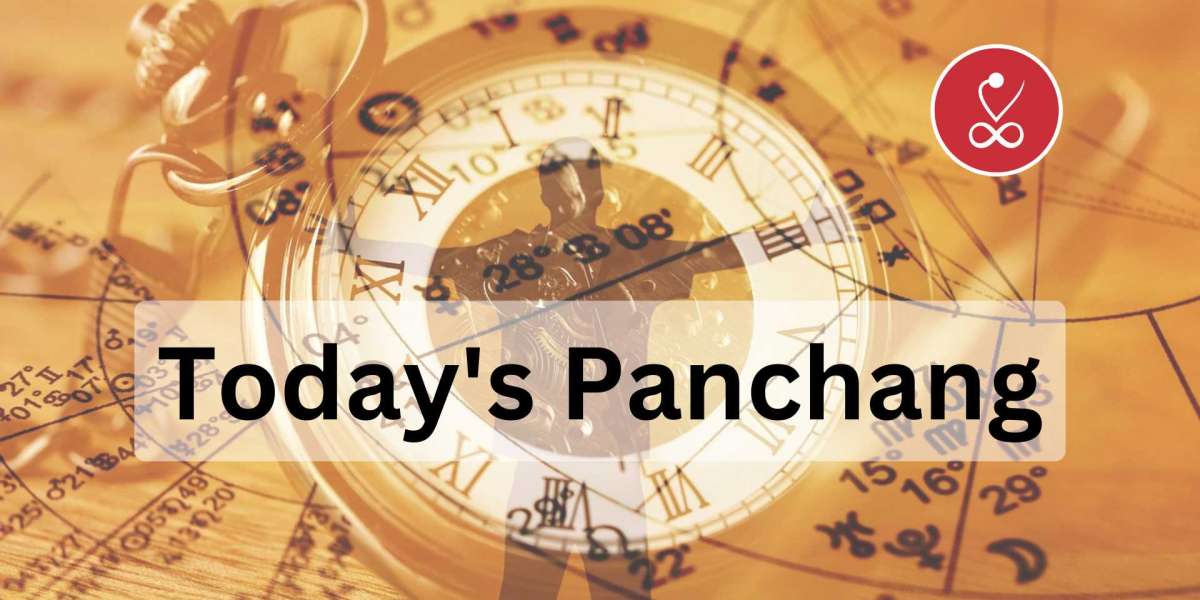Today's Panchang, often called the Hindu calendar, is a traditional system that guides daily activities through astronomical calculations. It holds a deep-rooted significance in Indian culture, tracing its origins to Vedic astrology. Whether it’s selecting an auspicious date for a wedding or aligning a religious ceremony, Panchang remains an indispensable tool.
Components of Panchang
A Panchang is composed of five key elements, each playing a significant role in determining the daily astrological and spiritual landscape. These components collectively guide rituals, celebrations, and other important events in the Hindu calendar.
- Tithi (Lunar Day):
Tithi represents the lunar day, determined by the angle between the sun and the moon. There are 30 Tithis in a lunar month, divided into two halves: Shukla Paksha (waxing phase of the moon) and Krishna Paksha (waning phase of the moon). Each Tithi carries specific spiritual and ritualistic importance, influencing festivals and ceremonies. - Nakshatra (Star Constellation):
Nakshatra refers to the 27 lunar constellations that form the backdrop for the moon’s movement in the sky. Each Nakshatra is associated with certain traits and is considered in astrological predictions, Muhurta selection, and naming ceremonies. - Yoga (Astronomical Alignment):
Yoga is a mathematical calculation based on the positions of the sun and moon. There are 27 Yogas, each with unique characteristics and influences on activities. Favorable Yogas are considered ideal for initiating new ventures. - Karana (Half of a Tithi):
Karana is one-half of a Tithi, totaling 11 Karanas in a lunar month. They are classified into two groups: movable (Chara) and fixed (Sthira). Specific Karanas are deemed auspicious for different purposes, such as travel or important decisions. - Vaar (Days of the Week):
The seven days of the week, or Vaar, are named after celestial bodies and hold specific significance. For instance, Monday is ruled by the moon and is associated with emotions and nurturing, while Thursday, ruled by Jupiter, is considered ideal for spiritual growth.
Role of Panchang in Daily Life
Panchang is not just a calendar; it’s a guide to harmonizing life with cosmic rhythms. Its relevance extends from spiritual practices to practical applications in everyday life.
Auspicious and Inauspicious Timings:
Panchang helps determine the right time to perform tasks, whether it’s starting a new business, hosting an event, or traveling. Auspicious timings, such as Abhijit Muhurta, are highly sought after, while periods like Rahukalam are avoided.
Muhurta: Choosing the Right Time:
Muhurta refers to a favorable time slot for undertaking significant activities. Based on the alignment of planetary forces, selecting the right Muhurta can enhance the likelihood of success and prosperity.
Spiritual and Ritualistic Applications:
Panchang is integral to planning Hindu festivals, rituals, and temple ceremonies. It ensures that these practices are aligned with cosmic energies for maximum spiritual benefit.
How to Read Today's Panchang
Reading Today's Panchang might seem complex at first, but with some understanding of its components, it becomes an invaluable tool for planning.
Understanding Basic Terminologies:
Familiarity with terms like Tithi, Nakshatra, and Yoga is essential. Many Panchang tools provide explanations alongside their calculations, making it easier to interpret.
Interpreting Astrological Alignments:
Panchang charts display the positions of celestial bodies, which can be analyzed to understand their influence on specific days. For example, a favorable Nakshatra on a particular day might be suitable for initiating a new venture.
Practical Applications in Modern Times:
Despite its ancient origins, Panchang remains relevant. Many professionals use it to align their personal and professional endeavors with auspicious timings, ensuring success and harmony.
Modern Tools for Accessing Panchang
Technology has brought Today's Panchang to our fingertips, making it more accessible than ever before.
Online Panchang Platforms:
Websites dedicated to astrological services provide detailed Panchang information for any location and date. They often include features like personalized horoscopes and festival dates.
Mobile Applications for Panchang:
Several apps are designed to deliver daily Panchang updates. These apps are user-friendly, allowing users to check auspicious timings, festival dates, and even planetary transits.
Traditional vs. Modern Methods of Accessing Panchang:
While traditional printed Panchangs remain popular in rural areas, modern tools like apps and websites cater to the tech-savvy generation. Both methods serve the same purpose, albeit with different approaches.
Spiritual Significance of Panchang
Panchang serves as a spiritual compass, guiding devotees in their religious and personal lives.
Connection to Vedic Astrology:
Panchang is deeply rooted in Vedic astrology, reflecting the interplay of celestial movements and their earthly impacts. This connection makes it a cornerstone of Hindu spiritual practices.
Influence on Religious Festivals and Events:
From Diwali to Navratri, Today's Panchang dictates the dates and timings of all major Hindu festivals. It ensures these events are celebrated at the most auspicious times.
Role in Hindu Ceremonies:
Whether it’s a wedding, housewarming, or naming ceremony, Panchang provides the framework for selecting dates and times that align with cosmic harmony.
Practical Examples of Today's Panchang
Understanding the intricacies of today's Panchang can help align daily activities with favorable cosmic energies. Below are some practical examples:
- Understanding Today’s Tithi and Nakshatra:
Today's Tithi and Nakshatra set the tone for the day. For example:
- Tithi: If the day corresponds to Shukla Panchami, it’s considered ideal for initiating educational activities.
- Nakshatra: A Nakshatra like Rohini brings prosperity and is favorable for financial endeavors.
- Good and Bad Times Today (Rahukalam and Yamagandam):
- Rahukalam: This inauspicious time period, calculated daily, is avoided for starting new ventures.
- Yamagandam: Another period considered unsuitable for important activities.
- Example for Today: If Rahukalam is between 1:30 PM and 3:00 PM, it’s wise to schedule crucial tasks outside this window.
- Aligning Daily Activities with Panchang:
Using the guidance of today's Panchang activities such as signing contracts, conducting rituals, or even planting trees can be harmonized with auspicious timings to maximize positive outcomes.
The Science Behind Panchang
Although deeply rooted in tradition, Panchang has a scientific basis tied to astronomy.
Astronomical Basis of Panchang:
Panchang calculations rely on precise astronomical observations, including the positions and movements of celestial bodies such as the moon and planets. These calculations are used to determine Tithi, Nakshatra, and Yoga.
The Connection Between Astronomy and Astrology:
While astronomy studies celestial phenomena objectively, astrology interprets these movements in terms of their influence on human life. Panchang serves as the bridge between these disciplines.
Accuracy and Relevance in Modern Times:
Despite technological advancements, Panchang remains relevant. Its accuracy stems from mathematical precision, and its predictions often align with astronomical data, proving its enduring utility.
FAQs About Today's Panchang
- What is Today's Panchang?
Today's Panchang provides detailed astrological information for the day, including Tithi, Nakshatra, and auspicious timings. - Can Non-Hindus Use Panchang?
Yes, Panchang can be used by anyone interested in understanding astronomical or astrological patterns. - Why Are There Variations in Panchang Data?
Variations occur due to differences in regional calendars and interpretations of astronomical data. - How Accurate Is Panchang in Predicting Events?
Panchang's accuracy depends on its alignment with astronomical data and traditional interpretations. - Where Can I Find Today's Panchang?
Many reliable sources, including online platforms and apps, provide accurate Panchang data. - Is Panchang Still Relevant in Modern Times?
Absolutely! Panchang continues to be a valuable resource for spiritual and cultural practices, even in today’s digital age.














